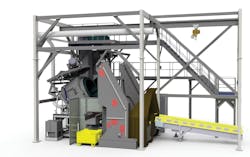Shotblast System Maximizes the Value of Metal Recycling
The Federal-Mogul Burscheid GmbH foundry in Germany casts steel, gray iron, and ductile iron parts for cars, trucks, and off-highway vehicles, for its own brand of powertrain components as well as components for other OEMs in automotive, agricultural, railway, and aerospace manufacturing.
To conserve resources, metal spills, gates, runners, and risers collected after shakeout are recycled into the casting process. Prior to re-melting, residual sand, casting scale, and any other tramp elements must be removed from the material to be recycled. Federal-Mogul uses a Rösler RMT 70-F model drum shotblast machine, selected in part because of its effectiveness in cleaning scrap materials prior to recycling.
The specific geometry of the Rösler multi-tumbler blasting drum is a primary factor in its effectiveness. The drum bottom contains a three-sided pyramid, and the inner drum wall is equipped with specially formed cams: The latter promotes lateral mixing of the workpieces, while the pyramid in the drum bottom ensures an effective exchange between the upper and lower workpiece layers.
Another factor that was persuasive to Federal-Mogul was the rugged machine concept specially adapted to foundry applications, including the welded construction of the machine frame made from 10-mm thick steel and the blasting drum made from 10-mm thick wear-resistant austenitic manganese steel.
The special foundry equipment version also includes a large inspection platform, which is easily accessible by a stairway. For quick mounting and dismounting of the turbine and blasting drum, the machine is equipped with a loading beam, with an electrical lifting and lateral transport device. Both allow quick and simple maintenance of the multi-tumbler, adding to the uptime for the blast machine.
The Rösler RMT 70-F's blasting process centers on the Gamma 400-8G turbine, specially designed for foundry operating conditions. In contrast to the traditional Gamma high-performance turbines, the Gamma 400-8G is equipped with eight throwing blades (rather than the standard six blades) and contains a tool steel wear lining. This feature reduces the wear of the throwing blades by up to 25%, which reduces maintenance and thus contributes to higher productivity and cost efficiency.
Like the Gamma high-performance turbines, the throwing blades are curved in the special “Y” design, which promotes 20% higher blast performance, with lower energy consumption. Because both blade sides can be used, a simple turn of the blades using a retaining bolt system effectively doubles their expected service life. Notably, this does not require disassembling the turbine.
A conveyor belt transports material to be recycled from the shakeout station to a LuT Metalltechnik impact crusher, which crushes the gates, runners, and risers, etc. into smaller pieces. Then, these are transferred to the fully automatic multi-tumbler loading station, equipped with weighing cells. Once the loading station reaches a preset maximum weight, 1.8 mt, the conveyor belt stops and the loading system transfers the crushed material into the blasting drum. Once loading is complete, the system returns to its base position.
Alternatively, the dual-action loading system can receive material from three different part bins.
During the shotblast cycle, the drum is hermetically sealed with a lid, so that blasting media is prevented from spilling or escaping. While the drum rotates at up to 10 RPM, the 45-kW turbine throws up to 560 kg/min of blast media at the material to be recycled. The rotational speed of the drum and the turbine can be adjusted easily with a frequency inverter.
The throw volume of blasting media can be adapted to the batch size, in combination with the multi-tumbling movement of the material in the drum, ensures that all pieces are equally exposed to the blast-media stream and all surface contaminants are removed. Removed scale and sand are siphoned from the drum and discharged through a dust collector.
Blast media is removed from the drum through custom-engineered screen inserts. Depending on the batch size and the density of the recycling material, processing time varies up to a maximum 10 minutes. At the conclusion of the blasting cycle, the drum tilts into unload position. Shotblasted material is deposited onto a vibratory conveyor and transported to part bins.
Shotblasting recycled material prior to remelting means that scale and sand contaminants are practically eliminated from furnace charges, meaning slag quantities are reduced, which reduces the wear rate of the furnace refractory lining, and conserves melting energy consumption. Moreover, the refractory lining serves longer between cleaning, increasing the furnace availability.

